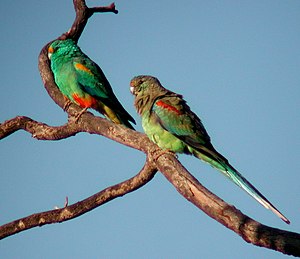Multicolored Parakeet
| Multicolored Parakeet | ||||||||||||
|---|---|---|---|---|---|---|---|---|---|---|---|---|

Multi-colored parakeet pair, left the male |
||||||||||||
| Systematics | ||||||||||||
|
||||||||||||
| Scientific name | ||||||||||||
| Psephotellus varius | ||||||||||||
| ( Clark , 1910) |
The multi-colored parakeet ( Psephotellus varius ) is a species of parrot from the genus Psephotellus .
description
The multi-colored parakeet reaches a length of 27 to 28 centimeters and a weight of 55 to 70 grams.
In the male, the head, neck, chest and upper abdomen are shiny green. The forehead is yellow and a reddish spot can be seen on the back of the head. The lower abdomen and thighs are yellow with a variable orange-red tint. The under tail-coverts are greenish-yellow. The bend of the wing, the coverts, the coverts and the outer flags of the wings of the hand are purple-blue. The outer small wing covers are yellow. The middle wing covers are bluish green. The outer arm wings are green with broad purple-blue borders. The rump and tail-coverts are green. A reddish-brown band runs over the upper tail-coverts and a blue-green line over the rump. The middle tail feathers are dark blue with a greenish wash. The beak is blackish. A narrow gray eye ring runs around the brown iris. The feet are gray-brown. The wax skin is pink.
In the female, the upper head, back and wings are olive green. The forehead is dull orange-yellow. A dull red spot can be seen on the back of the head. The breast is brownish green. The lower abdomen and tail-coverts are bluish green. The middle wing covers have a dull red wing spot. The wing undersides show a light wing stripe. The beak is brownish gray.
In immature birds the green color of the plumage is duller. The young males show a duller red color on the lower abdomen and a white band on the lower wings. The adult plumage is reached after six months.
The contact call is a whistle that is repeated three to four times. Occasionally a faint chirping can be heard.
Multicolored Parakeets can live to be 20 years old in human care.
distribution and habitat
The Mulga Parrot inhabits the dry Mulga - savannah and open woodlands. Its distribution area includes central Western Australia , the southern Northern Territory , South Australia , southwest Queensland , western New South Wales and the extreme northwest of Victoria .
Food and way of life
The multi-colored parakeet usually lives in pairs or in family groups. If food becomes scarce during the dry season, flocks of up to 100 birds can arise. The main activity is in the early morning and late afternoon. The food is taken up on the ground. In the event of disturbances and danger, he flies into a tree or bush and waits until the danger is over. It feeds on seeds, fruits, berries, vegetables, beetles and their larvae. Multicolored parakeets are nomadic and seek new habitats when the water sources dry out. They spend the hot hours of the day in the treetops. In flight, rapid, wave-like wing beats alternate with gliding phases.
It is incubated between July and December. The nest is built in small branch caves, eucalyptus trunks, crevices in the rock or caves in sand slopes. The clutch consists of four to seven eggs and is incubated by the female alone. The breeding season is 19 days and during that time the female is fed by the male. The young birds fled after about 30 days. The young birds often stay with their parents until the next brood.
literature
- J. Del Hoyo, A. Elliot, J. Sargatal (Eds.): Handbook of the Birds of the World. Volume 4: Sandgrouse to Cuckoos. Lynx Edicions, 1997, ISBN 84-87334-22-9 .
- Joseph M. Forshaw : Australian Parrots. 1st German-language edition. Volume 2, Arndt-Verlag, Bretten 2003, ISBN 3-9808245-2-7 .
Web links
- Videos, photos and sound recordings for Psephotellus varius in the Internet Bird Collection
- Psephotellus varius inthe IUCN Red List of Threatened Species 2017.3. Listed by: BirdLife International, 2016. Retrieved April 18, 2018.
